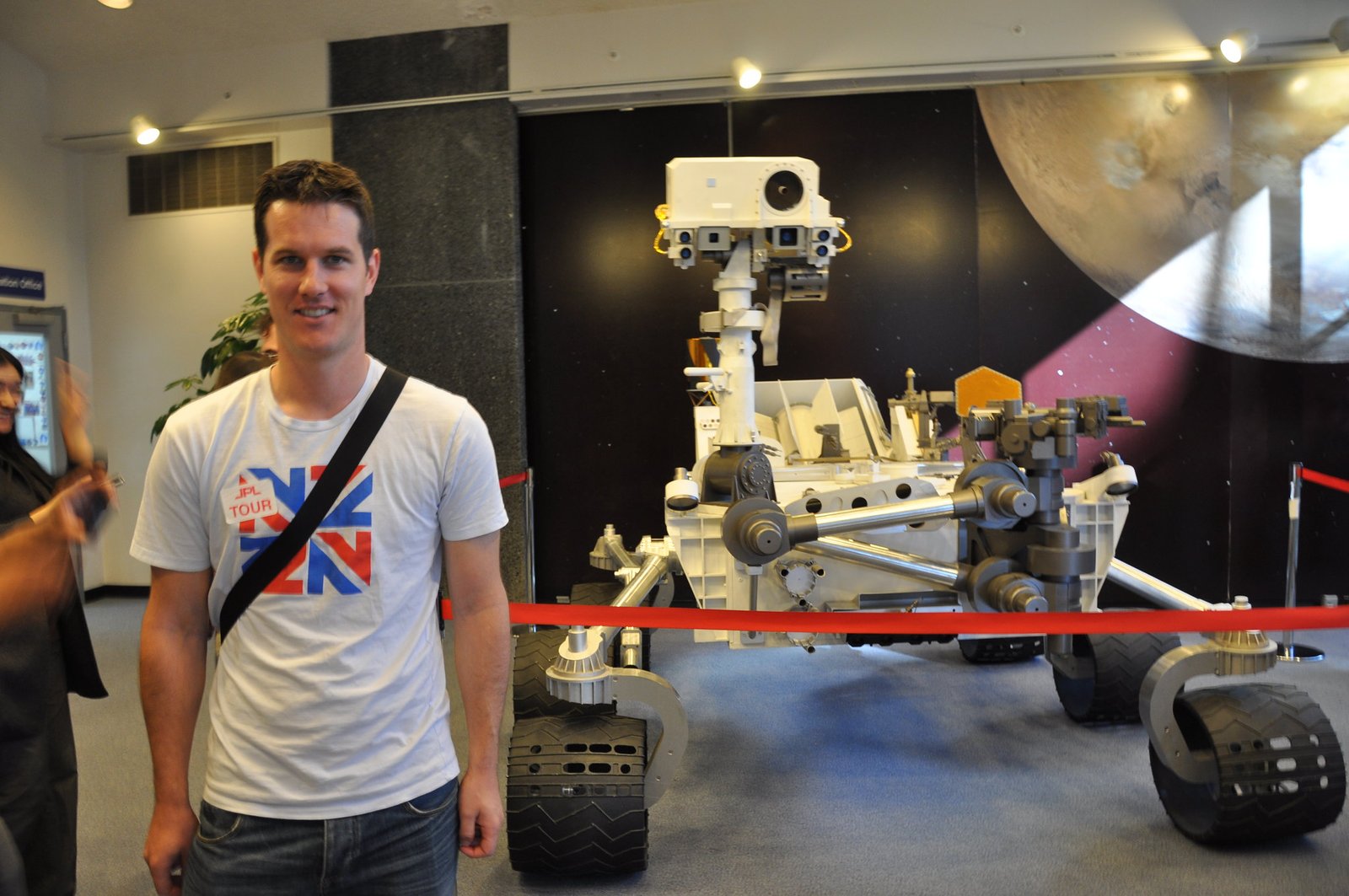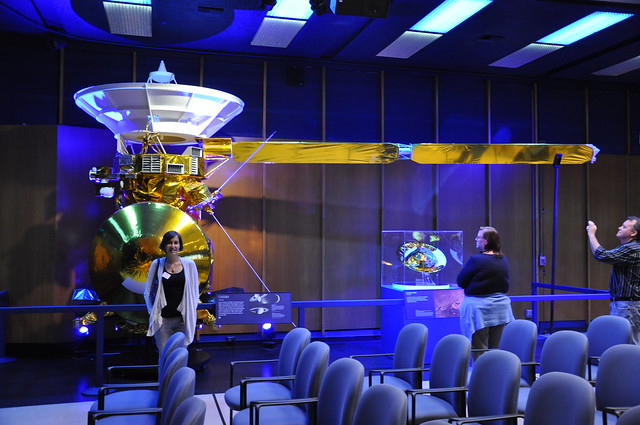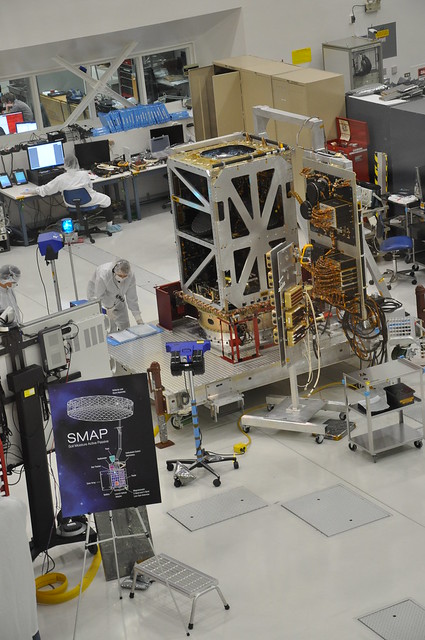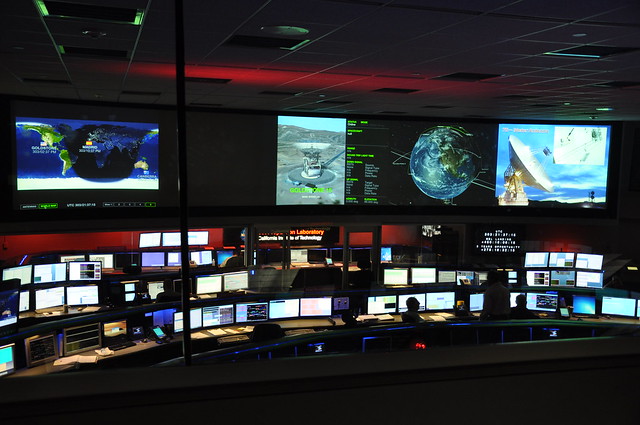Some of you may not know this, but I’m quite into my space stuff. And particularly Mars stuff. JPL, the Jet Propulsion Laboratory, is one of the most important parts of NASA these days. They’re the ones that design, build and monitor various satellites, probes and, most importantly, Mars robotic rovers. Exciting!!! There are free tours of the facility that you have to book months ahead for, so we made sure to get ourselves a spot for our LA stopover.
The first part of the tour, we got to see a few models of different probes that had been designed and built at JPL. This first one here is of Voyager 1, which has been travelling across our solar system for the last 36 years and is now in interstellar space. Amazing! Its twin, Voyager 2, is in the very outer solar system and is heading out to interstellar space as well. They were both launched in 1977 and between the 2 of them they have visited Jupiter, Saturn, Uranus, Neptune and Pluto. These probes are designed for the long haul – they should keep sending us telemetry until 2020. Then they will just cruise on carrying a record of ‘greetings’ in various languages, a collection of Earth music and examples of our science. Just in case anyone out there ever finds them. You can follow their progress on Twitter – Voyager and Voyager2.
Another model on display was of the Cassini probe which was sent to explore Saturn, its rings and its moons. Cassini was launched in 1997 and has returned a daily stream of data since arriving at Saturn in 2004. It, with the Hyugen probe, found that Saturn’s largest moon, Titan, has vast methane lakes and stretches of wind-sculpted hydrocarbon sand dunes. Another moon, Enceladus, was seen to have huge icy plumes and apparently the spray contains complex organic chemicals. The moon is also warmed by tidal pulls. This warmth with the presence of organic chemicals and potentially liquid water, makes Enceladus a place where primitive life forms might evolve. Neat!
There were also models of some of the first Mars rovers they sent to space – below is a model of Spirit/Opportunity and a model of the earlier and smaller Pathfinder. The rovers would cruise around Mars taking photos and testing rock or dirt samples. Pathfinder was originally designed to run for up to a month, but successfully ran for 3 months in 1997. Spirit landed on Mars in 2004 and lasted 6 years after it was designed for just a 3 month trip. Opportunity, who landed 3 weeks after Spirit, is still driving around today, 13 years later – impressive! Spirit and Opportunity also have their own twitter count – MarsRovers.
But these little rovers now have a big brother on Mars – Curiosity. This rover is the size of a small car! Its been on Mars for 1 year with a mission to find whether Mars ever had a ‘habitable’ environment to support life, where by life they mean microbes. The rover is driving around analyzing soil and drilled out rock samples. It also has a twitter feed, MarsCuriosity, so you can keep up to date with its latest news!
Next on our tour we got to see the Spacecraft Assembly Facility – 2 massive clean rooms where they construct the satellites and rovers. You can see half of 1 room here – its huge! Both of the bays have less than 10,000 particles of 0.5 micron (half a millionth of a meter or yard) or larger in size per cubic foot of air volume. That means that the air is the cleanest you’d ever breath. It’s a great place to work if you have allergies! The filtration system even managed to maintain acceptable levels when a brush fire raged near JPL in 2009. Impressive!
When we visited, they were building SMAP (Soil Moisture Active Passive), an Earth-orbiting satellite which will measure soil moisture and freeze/thaw state from space. While JPL is well known for its satellites and rovers in outer space, they spend just as much time on Earth-based projects so we can learn more about our planet. SMAP is designed to send radar and radio waves down to Earth then pick up the reflections with a large circular mesh reflector. The changes in the reflections tell scientists how much moisture is in the land and ice that’s being scanned. Clever! In the front left of this picture is a poster of SMAP and behind it to the right is the silver and black body of SMAP. You can see the scientists in their white coats, hairnets and face masks too.
The last thing we saw on the tour was the Space Flight Operations Facility. This isn’t where the launches are handled – that’s in Florida. But after the rover or probe reaches space, then the spacecraft tracking and scientific data are received and processed through JPL’s Deep Space Network. The Deep Space Network is essentially a collection of powerful antennae with 3 big ones – one in Madrid in Spain, one in Goldstone in the US and one in Canberra in Australia. Because they’re evenly spread around the world, that means there will always be at least one of these antennae pointing at the rovers and probes at one time. This means JPL can track and monitor 24 hours a day!
I thought this tour was brilliant -and it was free! I was a bit wide-eyed visiting my first NASA facility, especially the main robotics one, so its unsurprising that I enjoyed it. But I think the tour was very accessible thought if you have an interest in space stuff. The guides are very knowledgeable too and can answer any questions you might have as well.
Finding out more about how NASA works, I don’t think I would’ve enjoyed working on these kind of projects. It seems to take years and years to get a project approved and then into development and then to launch. At least the projects are designed to last years as well, but the bureaucracy might’ve driven me nuts first. Still, I’m happy to enjoy the fruits of their labour years after the fact by getting all the images and articles on twitter.
We had a lovely couple of days in LA, and there’s one more blog post about our trip to go. Next, we’re going to see mammoths. Well, the bones of some, at least.
Until next time…











